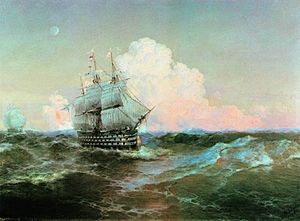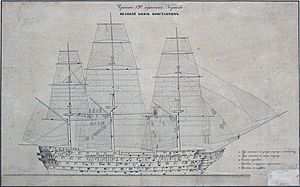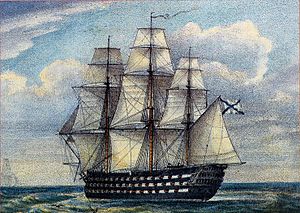Russian ship Dvienadsat Apostolov (1841) facts for kids
class="infobox " style="float: right; clear: right; width: 315px; border-spacing: 2px; text-align: left; font-size: 90%;"
| colspan="2" style="text-align: center; font-size: 90%; line-height: 1.5em;" | 
|} The Dvienadsat Apostolov (which means "Twelve Apostles" in Russian) was a very large warship called a ship of the line. It was the first of its kind, with three similar ships planned. This powerful ship was built for the Imperial Russian Navy and finished in 1842.
It spent its entire service with the Black Sea Fleet. Dvienadsat Apostolov played a part in defending the city of Sevastopol during the Crimean War. Instead of fighting at sea, its cannons were moved to help protect the city from land attacks. The ship was later used as a hospital ship to care for the wounded. In February 1854, it was sunk on purpose to block the harbor entrance at Sevastopol.
Contents
| History | |
|---|---|
| Name | Dvienadsat Apostolov |
| Builder | S. I. Chernyavskiy, Nikolaev |
| Laid down | 4 October 1838 |
| Launched | 15 July 1841 |
| Completed | 1842 |
| Fate | Scuttled at the Siege of Sevastopol, 25 February 1854 |
| General characteristics (as built) | |
| Class and type | 120-gun Dvienadsat Apostolov-class ship of the line |
| Displacement | 4,790 long tons (4,870 t) |
| Tons burthen | 3,190 tons (bm) |
| Length | 211 ft 2 in (64.36 m) (p/p) |
| Beam | 59 ft 6 in (18.14 m) |
| Draft | 25 ft 9 in (7.85 m) |
| Armament |
|
- Early Voyages and Missions
- Role in the Crimean War
- Becoming a Hospital Ship and Its End
- Legacy and Memorials
What Was the Dvienadsat Apostolov?
The Dvienadsat Apostolov was a "first-rate" ship of the line. This means it was one of the biggest and most powerful warships of its time. It was designed to carry many cannons on several decks.
Ship Size and Design
The design for the Dvienadsat Apostolov class was thought to be based on a British warship from 1839. This ship was about 61.7 meters (202 feet 8 inches) long. It had a width (beam) of about 18.1 meters (59 feet 6 inches).
The ship sat deep in the water, with a draft of about 7.8 meters (25 feet 9 inches). When fully loaded, it weighed about 4,790 metric tons.
Ship's Powerful Weapons
The Dvienadsat Apostolov had many cannons on different decks.
- Lower Deck: It had 28 modern Paixhans guns. These cannons were designed to fire heavy 68-pound explosive shells. This type of cannon was new to the Russian Navy in 1838. There were also four 36-pounder long guns.
- Middle Deck: This deck held 34 shorter 36-pounder cannons.
- Upper Deck: Here, there were 34 36-pounder gunnades.
- Forecastle and Quarterdeck: These areas had 24 24-pounder gunnades. There were also smaller cannons called carronades: one 24-pounder, two 12-pounders, and two 8-pounders.
Life and Service of the Ship
The building of Dvienadsat Apostolov began on October 4, 1838. It was built at the Nikolaev shipyard, which is now Mykolaiv. The ship was officially launched into the water on July 15, 1841.
Early Voyages and Missions
Its first journey was in 1842, sailing from Nikolaev to Sevastopol, which was the main base for the Black Sea Fleet. After that, it cruised around the Black Sea. The ship's first commander was Captain Vladimir Kornilov, who later became an admiral.
In 1843, Dvienadsat Apostolov helped move 1,466 soldiers from Sevastopol to Odessa and then brought them back. It continued to sail in the Black Sea for several years, from 1843 to 1847 and again from 1849 to 1850. The ship was updated between 1851 and 1852, and its smaller carronade cannons were removed.
Role in the Crimean War
In October 1853, the ship transported 1,466 Russian troops. They went from Sevastopol to Sukhum Kale (now Sukhumi in Georgia). This was because the Crimean War had started, which also affected the Russo-Circassian War.
When it returned to Sevastopol in April 1854, the ship helped defend the port. Its cannons and the sailors who operated them were moved onto land. They set up an artillery battery (a group of cannons) named after the ship. By December 1854, all of its cannons had been moved ashore.
Becoming a Hospital Ship and Its End
With its cannons gone, only about 80 sailors stayed on board. They turned the ship into a temporary hospital. This was completed on December 18, 1854.
On February 13, 1855, Dvienadsat Apostolov was sunk on purpose. It was part of a line of ships sunk to create a barrier. This was done to stop the British and French fleets from entering the harbor.
Legacy and Memorials
A Russian naval flag, believed to have been taken from the ship, is now kept at the National Maritime Museum in Greenwich. In 1905, a special monument was built in Sevastopol Harbor. It is called the Monument to the Sunken Ships and marks 50 years since the siege. It remembers the ships of the Black Sea Fleet that were sunk to protect the city.



